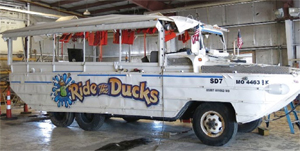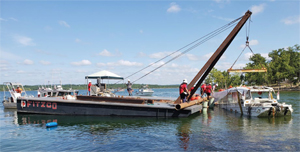Stretch Duck 7 entered Table Rock Lake near Branson, Mo., on a warm summer evening with 31 people on board. Barely 10 minutes later, a powerful storm front passed, generating 70-mph winds and 3-foot waves on the previously flat lake.
The World War II-era DUKW amphibious vessel sank 250 feet from an exit ramp after waves flooded the duck boat through an air intake hatch on the bow, the National Transportation Safety Board (NTSB) said in its report on the July 19, 2018, incident. Passengers and crew had only seconds to escape, and 17 people died. Another six people were injured.
The NTSB attributed the incident to the decision by the vessel operator, Ride the Ducks Branson, to continue running the waterborne portion of the tour despite a severe thunderstorm watch issued hours earlier.
“Contributing to the sinking was the Coast Guard’s failure to require sufficient reserve buoyancy in amphibious vessels,” the NTSB said in its report issued this spring. “Contributing to the loss of life was the Coast Guard’s ineffective action to address emergency egress on amphibious passenger vessels with fixed canopies, such as Stretch Duck 7, which impeded passenger escape.”
The Coast Guard is still conducting inquiries into the Stretch Duck 7 sinking, one focused on safety and the other a criminal investigation with support from the U.S. Justice Department, service spokesman Barry Lane said.
“The Coast Guard agrees with the NTSB that the canopy likely impeded passenger egress and we now recommend all canopies be removed prior to DUKW vessel operations,” Lane said, referring to a marine safety information bulletin the service issued in April 2020.
The incident involving Stretch Duck 7 in some ways resembled a 1999 duck boat sinking near Hot Springs, Ark., that left 13 people dead. The NTSB report into the Miss Majestic incident highlighted similar safety issues, including lack of reserve buoyancy and escape issues posed by the fixed canopies.
Following that incident, the Coast Guard did not heed NTSB recommendations to require additional passive reserve buoyancy and remove canopies. The Coast Guard has not committed to regulatory changes after the Stretch Duck 7 sinking.
“The Coast Guard will use the NTSB and MBI (Marine Board of Investigation) findings to update official policy for DUKWs and to determine the need for any regulatory actions,” Lane said.
The 33-foot Stretch Duck 7 was one of nearly 21,000 amphibious vehicles built for use during World War II. According to the NTSB, these vehicles were expected to last just a few months. The first such use of these vehicles for tourism started in Branson in 1971, the report said. One trait of these vessels: Their internal hulls are essentially open fore to aft.
This particular DUKW went to work in the early 1980s for a different tour operator, and in 1996 it underwent substantial modifications. These included extending the length by 15 inches (thus the “stretch” name) and deepening the hull at the stern. Propulsion over land and water came from a 235-hp Chevrolet engine.
Stretch Duck 54, a more recent DUKW model that entered Table Rock Lake just before Stretch Duck 7 on the day of the fatal sinking, was 6 inches wider at the beam, with a gunwale running 6 inches higher. It also had a securable bow hatch to prevent flooding. Stretch Duck 54 made it back to land moments before Stretch Duck 7 sank.
 |
|
Stretch Duck 7, shown in a post-accident photo, had a fixed canopy that impeded passenger escape as the vessel sank. “Initial water ingress … was likely from waves rolling over the air intake hatch’s spring-loaded damper and intermittently opening it,” the NTSB said. |
|
NTSB photo |
“Initial water ingress to Stretch Duck 7 was likely from waves rolling over the air intake hatch’s spring-loaded damper and intermittently opening it, thereby allowing water into the engine compartment,” the NTSB said.
Stretch Duck 7 completed four 90-minute tours in and around Table Rock Lake on the day of the sinking. The National Weather Service issued a severe thunderstorm watch for Table Rock Lake at 1120 that remained in effect until 2100. Just before its final voyage, at 1827 a Ride the Ducks manager told Stretch Duck 7’s captain and driver to complete the waterborne component of the tour earlier than normal, the NTSB report said. The discussion, captured on the DUKW’s digital video recorder, did not include a reason for the change.
Passengers began boarding Stretch Duck 7, with a warning from the captain of some impending weather. The DUKW left at 1833, one minute after the National Weather Service issued a severe thunderstorm warning for an area that included Table Rock Lake. The service predicted wind gusts of up to 60 mph. The tour continued, and Stretch Duck 7 entered a calm, eerily flat Table Rock Lake at 1855. Three other company vessels also entered the lake after the warning was issued, investigators said.
The voyage was normal until about 1900, when the winds suddenly picked up. The captain of Showboat Branson Belle, docked near the lake’s exit ramp, recalled the winds went from light to more than 50 mph in 90 seconds. Stretch Duck 54 left the lake at 1907 as Stretch Duck 7 struggled to make headway. The vessel listed to starboard and sank at the stern near Showboat Branson Belle.
Survivors recalled water coming up through the floorboards and through the starboard-side opening just before the duck boat sank. “Several passengers stated that the water, which rose from their feet to their shoulders as they stood up, filled Stretch Duck 7 within seconds,” the NTSB wrote in its report. “One passenger said the rate of water ingress seemed ‘almost instantaneous.’ Several passengers recalled reaching for a life jacket around this time but were unsuccessful because of the rapid flooding.”
Passengers and crew aboard Showboat Branson Belle rescued survivors from the water in challenging conditions. Winds gusted to 73 mph and heavy rain fell. The storm front that passed through Table Rock Lake is known as a derecho, or straight line of thunderstorms.
Stretch Duck 7 had a Coast Guard five-year certificate of inspection (COI) last renewed in February 2017. It specified passenger limits and where and under what conditions the DUKW could operate on the water. The COI stipulated water operations were not allowed when winds exceeded 35 mph and waves exceeded 2 feet.
The NTSB highlighted shortcomings in Ride the Ducks internal policies that deferred operational decisions to captains. These captains, the report said, often lacked up-to-date weather information available to managers back in the office. The company also lacked a policy pertaining to “no-go” orders for its boats.
“A go/no-go policy would provide a means to negate personal and professional pressure to accommodate expectant passengers who have booked and paid for tours,” the NTSB said. “Decision-makers thereby are relieved from having to make decisions based on individual assessments … rather than well-defined and established criteria.”
Ripley Entertainment of Orlando, Fla., owned Ride the Ducks at the time of the sinking. The company has settled numerous lawsuits stemming from the incident, and it has since left the duck boat business.
“We are reviewing the National Transportation Safety Board’s report,” Ripley spokeswoman Suzanne Smagala-Potts said in an email. “(Ride the Ducks Branson) fully cooperated with the NTSB’s investigation into the accident. … We remain dedicated to working with the community of Branson, and continuing our support of all those who were impacted by the accident.”
At least five key personnel with Ride the Ducks Branson did not cooperate in the NTSB investigation, including the captains of Stretch Duck 7 and Stretch Duck 54, which on the evening of the incident was helmed by the company’s general manager. The manager who suggested altering Stretch Duck 7’s route also did not cooperate. A footnote in the report suggests the ongoing criminal investigation might have influenced those decisions.
 |
|
A memory card from Stretch Duck 7’s digital video recorder system. Investigators retrieved and reviewed audio and video data from the system, which provided details of the circumstances leading up to the fatal sinking. |
|
NTSB photo |
In its recommendations, the NTSB reiterated its earlier request for the Coast Guard to require DUKWs to have sufficient reserve buoyancy to remain afloat during flooding or other damage. It also requested that the Coast Guard require DUKWs without sufficient reserve buoyancy to remove canopies and side curtains that can block exits during a sinking.
The agency urged the Coast Guard to mandate that amphibious passenger vessels with forward hatches like the one on Stretch Duck 7 have secure closing mechanisms that can be operated during waterborne operations to prevent downflooding. It also called for new training among duck boat personnel to identify potential severe weather before it arrives.
The Passenger Vessel Association (PVA), a trade group that includes duck boat operators, said it is working with its members to share key points of the NTSB report.
“The NTSB recommendations apply only to World War II vintage DUKWs and to ‘stretch’ DUKWS, not to all amphibious vehicles,” the PVA said in a prepared statement. “(We await) the Coast Guard’s investigatory report and any resulting regulation to help identify the path forward for these members.”
It’s not clear what impact the NTSB and Coast Guard safety recommendations will have on the industry. A Boston Duck Tours official told a local newspaper this spring it has no plans to remove fixed canopies from its “truck ducks” — modern DUKW variants — despite the recommendation from both federal agencies.

